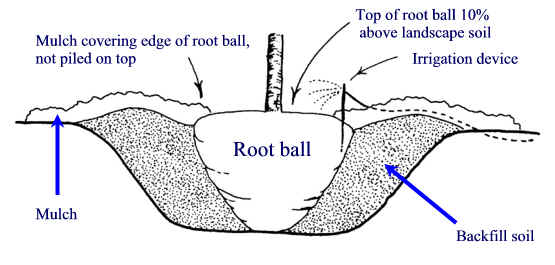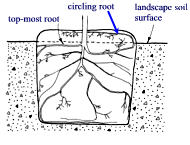Home > Planting trees > Planting hole size and configuration
Planting hole size and configuration
Appropriate planting detail
Inappropriate planting detail 
Planting and establishing trees is all about managing air and moisture in the soil. Manage these correctly and trees will grow quickly following planting. Four of the most common causes of poor plant establishment are 1) planting too deeply, 2) under watering, 3) over watering and 4) over-mulching (See: over-mulching). Planting too deeply in compacted soil can also lead to very slow root development. Each of these problems can lead to extensive tree death, poor growth, or a slow decline after planting. If appropriate trees are planted at the right depth and they are irrigated properly, the planting has a good chance of success. As simple as this appears to be, problems often arise that lead to poor establishment or plant failure.
 Before
digging the hole, 1) find the point where the top-most root emerges from the trunk (dig down next to the trunk to find this point), and 2) measure the distance between the top-most
root and the bottom of the root ball. Dig the hole slightly shallower
than this depth and as wide as possible (at least 1.5 times the width of the
ball-dig a much wider and shallower hole in compacted
soil). Do not dig the hole deeper than the root
ball. Consider drilling holes below the root ball in compacted soil or rock to encourage some deep roots.
Before
digging the hole, 1) find the point where the top-most root emerges from the trunk (dig down next to the trunk to find this point), and 2) measure the distance between the top-most
root and the bottom of the root ball. Dig the hole slightly shallower
than this depth and as wide as possible (at least 1.5 times the width of the
ball-dig a much wider and shallower hole in compacted
soil). Do not dig the hole deeper than the root
ball. Consider drilling holes below the root ball in compacted soil or rock to encourage some deep roots.
When planting on slopes set the tree so the top-most root in the ball on the uphill side is about even with the soil. The side of the root ball on the downhill side will be well above the surrounding soil. Bring in enough soil to cover the sides of the root ball with soil. Apply mulch to finish the planting job as shown in the diagram above.
When planting in rock or very compacted soil break up the substrate as best as possible to allow roots to anchor into the landscape (see: how to break up soil). If this is not done, roots are likely to be very shallow and the tree may grow poorly. Drilling holes in rock below the root ball might help encourage some deep roots that could help secure the tree in windy weather.

